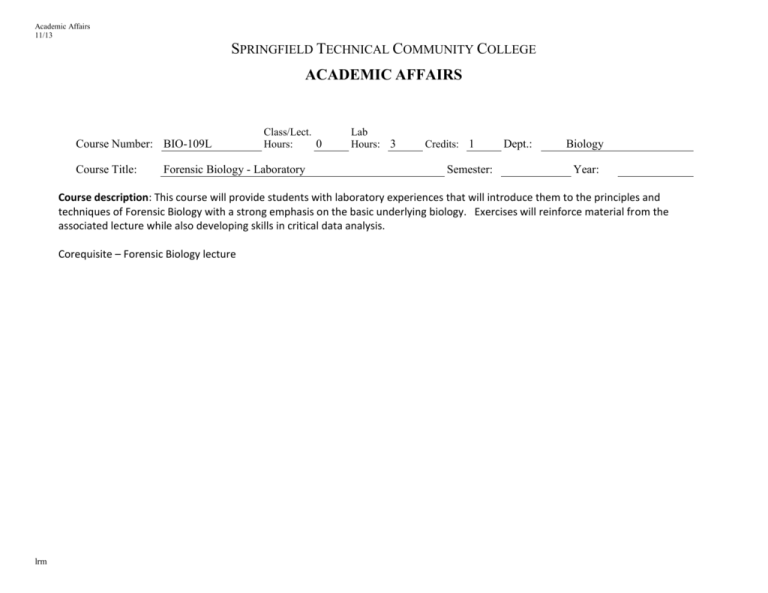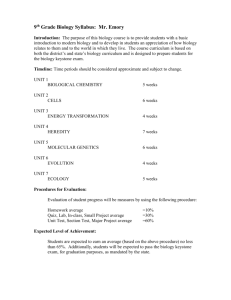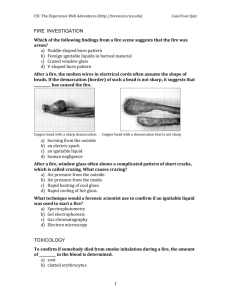BIO-109L - Springfield Technical Community College
advertisement

Academic Affairs 11/13 SPRINGFIELD TECHNICAL COMMUNITY COLLEGE ACADEMIC AFFAIRS Course Number: BIO-109L Course Title: Class/Lect. 0 Hours: Forensic Biology - Laboratory Lab Hours: 3 Credits: 1 Semester: Dept.: Biology Year: Course description: This course will provide students with laboratory experiences that will introduce them to the principles and techniques of Forensic Biology with a strong emphasis on the basic underlying biology. Exercises will reinforce material from the associated lecture while also developing skills in critical data analysis. Corequisite – Forensic Biology lecture lrm Course Number: Page 2 Course Number: Page 3 Course Objectives Competencies Course Number: Page 4 Primary learning goals addressed: 1. Quantitative literacy 2. Critical thinking 3. Computer literacy 4. Written and oral communication Lab safety. Measurement and the metric system 1. Knowledge of the safety features of the lab. 2. Knowledge of appropriate safety behavior in the lab. 3. Knowledge of metric units, metric measurement and metric conversions. 4. Demonstrate quantitative reasoning in performing these calculations. Lab calculations and solution making 1. Demonstrate ability to calculate moles and dilution ratios. 2. Demonstrate ability to make and dilute solutions of an indicated molarity, ratio, or volume. Microscopy and asceptic technique 1. Demonstrate ability to use and properly handle microscope. 2. State the concepts of asceptic technique. 3. Demonstrate asceptic technique Spectrophotometry – salicylates in blood 1. State the principles of spectrophotometry 2. Perform a spectrophotometric analysis and interpret the results. Serology – Blood typing 1. State the biologic principles of blood typing. 2. State the biologic relevance of humans having blood of different immunological types. 3. Perform blood typing and interpret the results Chromatography – Analysis of pigments in biological materials of various origin 1. State the phyiscial principles of chromatography. 2. State three or more uses of chromatography. 3. Perform a chromatographic analysis and interpret the results. Gel electrophoresis – Is this blood human? 1. State the physical principles of gel electrophoresis. 2. Perform an electrophoretic analysis and interpret the results. Course Number: Page 5 Course Objectives Polymerase chain reaction. Blood spatter analysis Crime scene analysis Competencies 1. State the principle and basic steps of the polymerase chain reaction. 2. Succesfully perform a polymerase chain reaction. 1. Succesfully analyze blood spatter pattens to determine the angle of impact. 2. State the importance of knowing the angle of impact. 1. Use information learned in the course to demonstrate the ability to critically observe a simulated crime scene, determine what evidence to gather, what tests to perform; and how to use the data to draw conclusions concerning the putative crime. 2. Use written and oral communication skills to communicate the student’s chain of reasoning and conclusions concerning the crime scene analysis.










